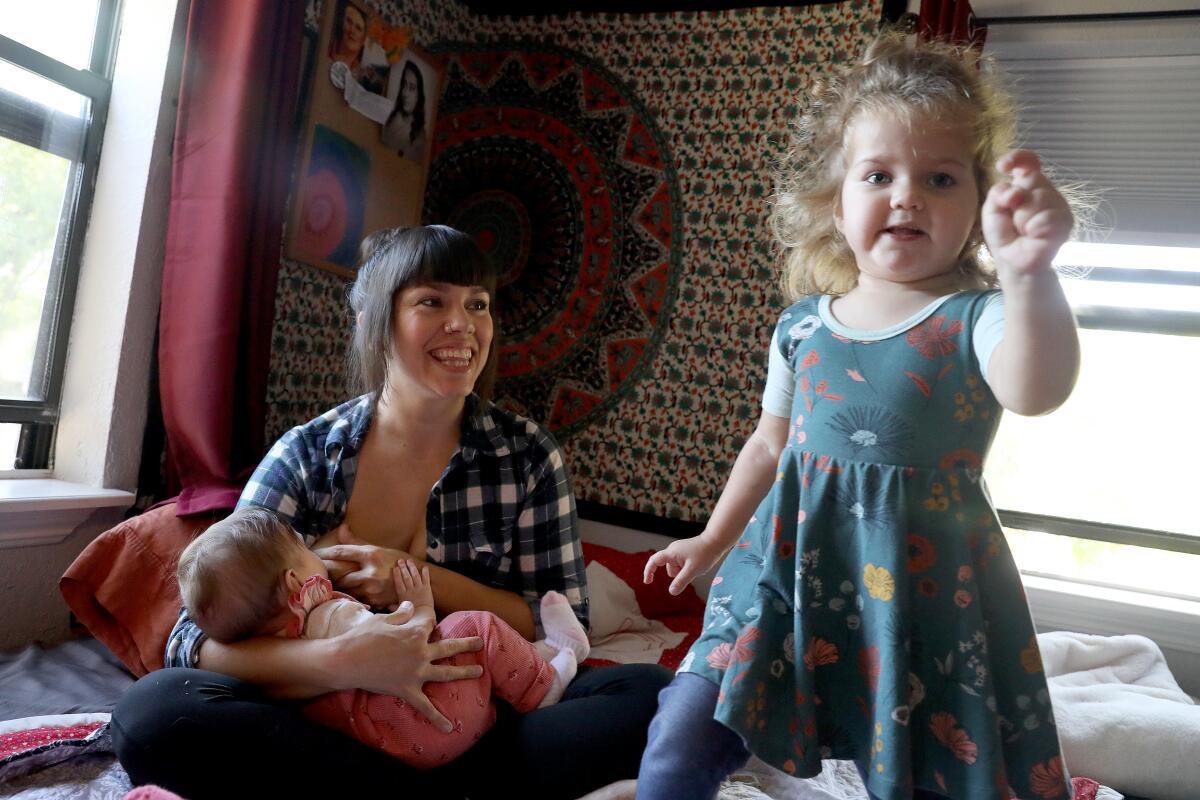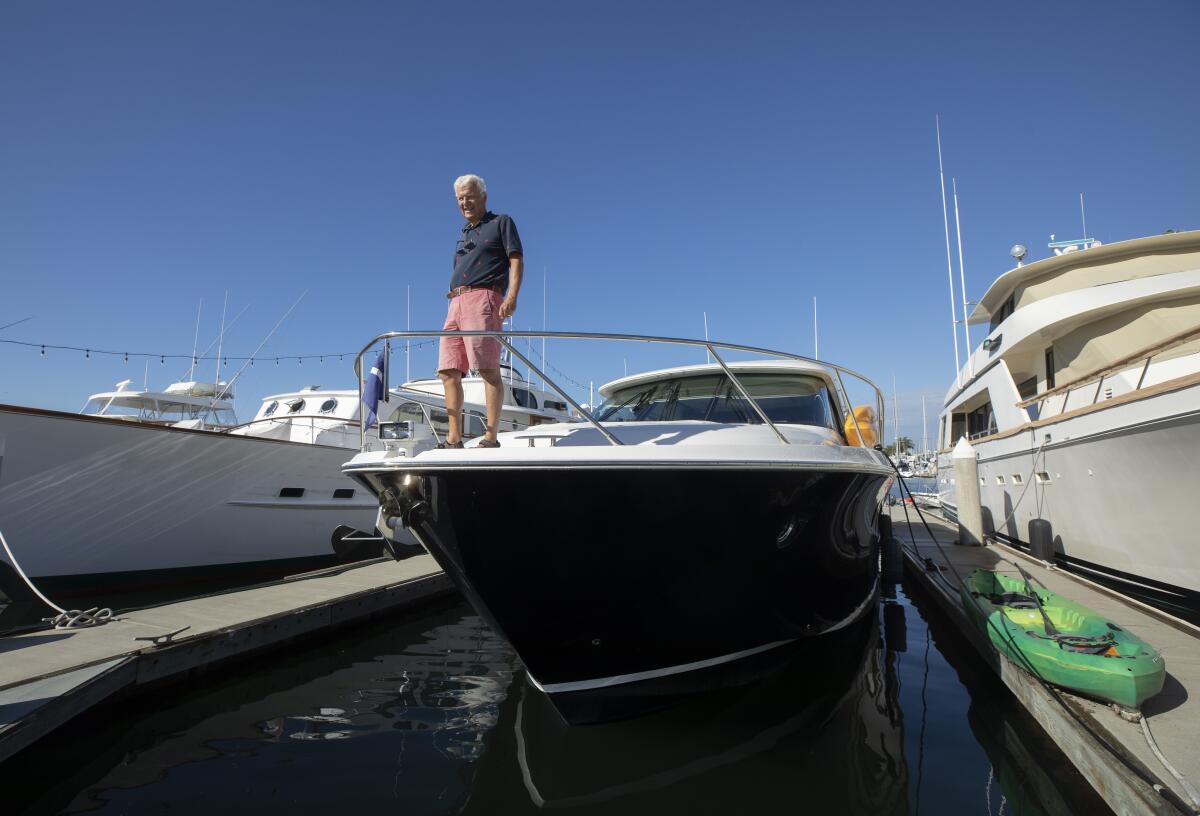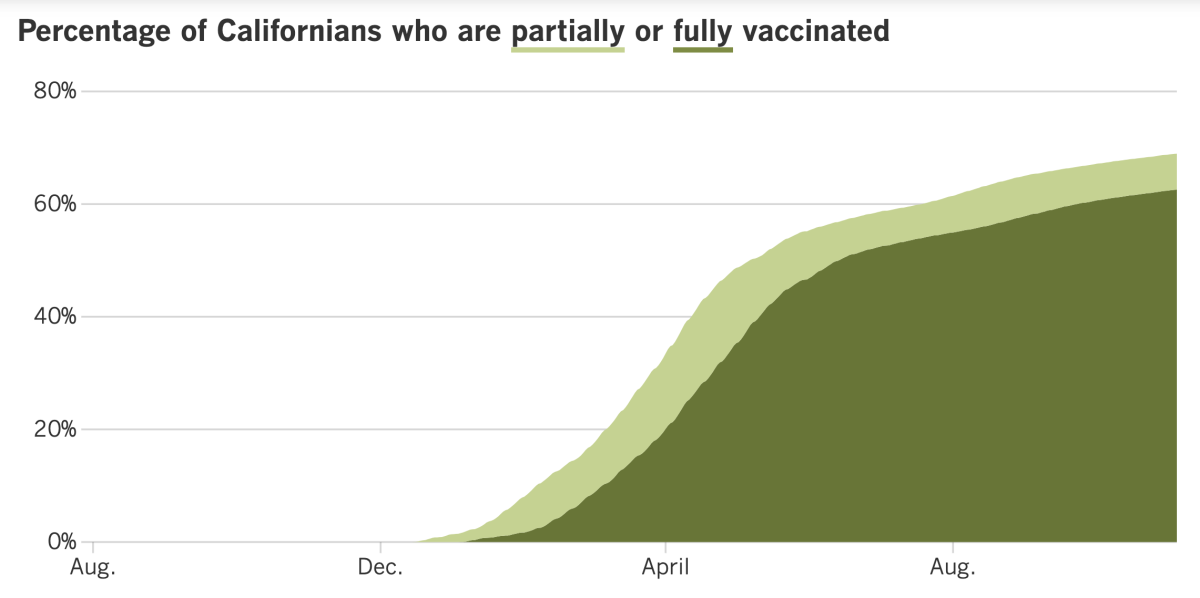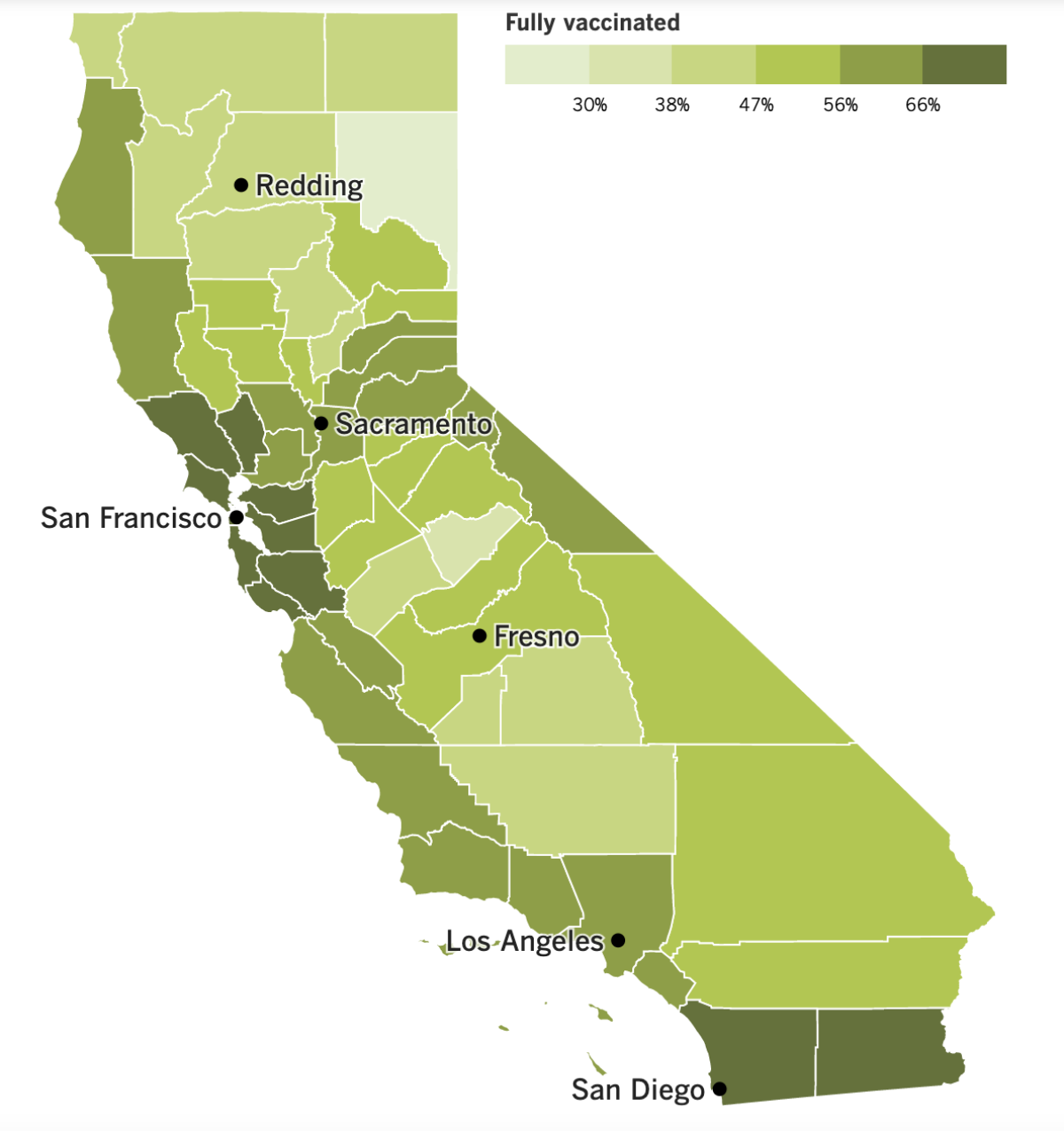Coronavirus Today: A DIY COVID-19 ‘vaccine’
- Share via
Good evening. I’m Karen Kaplan, and it’s Friday, Nov. 5. Here’s the latest on what’s happening with the coronavirus in California and beyond.
It’s been a big week for the 28 million elementary-school children who have become eligible for Pfizer and BioNTech’s kid-sized COVID-19 shots. Now the only ones left without access to a vaccine are infants, toddlers and other youngsters in the 4-and-under set.
Some enterprising mothers have come up with a work-around to get coronavirus antibodies into their children — through breast milk.
Sacramento mom Melissa Pennel was vaccinated when she was 40 weeks pregnant with her second child. She had been planning to nurse her newborn anyway, but when she learned that her milk would contain the precious antibodies, she started thinking of ways to feed some of her milk to her 2-year-old as well.
Could she replace the usual milk in Matilda’s cereal with breast milk? Use it to make oatmeal? Sneak it into smoothies?
All of those strategies have worked.
“Part of it is mental and feeling like I have protection over my family,” said Pennel, who pumps milk every night for this purpose.

No less an authority than Dr. Anthony Fauci has called on new mothers to be vaccinated (if they haven’t done so already) and nurse their babies to provide them with coronavirus-fighting antibodies.
“Antibodies found in breast milk show strong neutralization of virus, protecting your newborn baby,” Fauci said at a White House briefing in August. “The bottom line: Get vaccinated.”
Mireya Tecpaxohitl Gonzalez did. Now she has an extra incentive to keep nursing her 3-year-old son and 7-year-old daughter. She said she’d talked with her first-grader about weaning, but the little girl knows about the antibodies and doesn’t want to give them up, Gonzalez said.
“We call them little warriors in the milk, and she’s willingly drinking it,” the Panorama City woman said. “She knows about the pandemic.”
Does this do-it-yourself approach to a COVID-19 vaccine actually help in the real world? Pennel offers some anecdotal evidence that it does.
Her nanny had a coronavirus infection, and in all likelihood, she had been carrying the virus for a week before she realized it. During that time, she held and played with Pennel’s daughters, but they weren’t infected themselves.
Pennel said she liked to think her breast milk deserved the credit for that.
By the numbers
California cases and deaths as of 3:30 p.m. on Friday:

Track California’s coronavirus spread and vaccination efforts — including the latest numbers and how they break down — with our graphics.
We’re not all in the same boat
Thank goodness it’s Friday. Got plans for the weekend? If they include some time on a yacht, count yourself among the lucky ones.
Anyone with access to a yacht is fortunate, of course — and that’s especially true during COVID Times. The pandemic has put a premium on watercraft, leading to the largest gap between supply and demand since the profligate days before the Great Recession.
“We can’t get boats fast enough,” yacht broker Trenton Carroll told my colleague Andrea Chang. “I’ve got boats sold out to 2023 that won’t be here for a year and four months, and yet people are willing to wait because they know there’s nothing else around.”
That’s hardly what Carroll and other brokers expected when the economy went into lockdown last year. Before the first reports of a mysterious flu from Wuhan, the National Marine Manufacturers Assn. had anticipated that new boat sales in 2020 would be 2% higher than in 2019. In reality, they soared by 13%. And in the first quarter of 2021, sales were 30% higher than in the first quarter of 2020.
All told, Americans purchased more than 1.3 million new and used boats in 2020 as stir-crazy people with means embraced the vessels as a COVID-safe escape. Boarding a boat was a lot less risky than boarding a plane, and a lot more exciting than buckling into a car for a road trip.

The economy as a whole may have been struggling, but that wasn’t the case for those at the top. The stock market surged, with the Standard & Poor’s 500 index gaining 16.3% in 2020 and ending the year at an all-time high. The Nasdaq composite index increased a whopping 43.6%. Investments in real estate and bitcoin surged as well. All that allowed roughly 415,000 Americans to buy their first boat last year.
(In case you’re wondering, there’s no set way to differentiate a “boat” from a “yacht.” But a spokesman for the California Yacht Club offered this rule of thumb: “When you go in and say, ‘How much?’ it’s a boat. When you say, ‘I don’t care what it costs,’ that’s a yacht.”)
That explains the demand side. On the other side of the equation are the same kinds of supply chain problems responsible for shortages of products from refrigerators to toys.
Companies that make boats can’t get their hands on enough fiberglass, stainless steel, resin and other materials. Nor can they find enough skilled workers to turn the materials they have into seaworthy vessels.
And that’s why Bill Wolf of Sherman Oaks has been inundated with unsolicited offers to buy Pied-a-Mer, his 2016 black-and-white Tiara 53 powerboat. The semiretired accountant figured the boat had lost about 20% of its value in the first year or two after be bought it. Now people are willing to pay him more than the $1 million he shelled out five years ago.
“It’s tempting to sell,” he said.
California’s vaccination progress


See the latest on California’s vaccination progress with our tracker.
Your support helps us deliver the news that matters most.
In other news ...
Let’s get the disconcerting news out of the way first: A new study involving more than 780,000 people has found that the protective power of all three COVID-19 vaccines in use in the U.S. saw significant declines over a six-month period when the Delta variant was on the rise.
For people who received the Moderna vaccine, the effectiveness of the shots fell from 89% in March to 58% in September. For those who got the Pfizer-BioNTech vaccine, effectiveness dropped from 87% to 45% over the same period. And here’s the real whopper: The effectiveness of the Johnson & Johnson jab plunged from 86% to only 13%.
The vaccines did a better job of preventing breakthrough cases from becoming fatal. Among people ages 65 and older, the Moderna vaccine was 76% effective at preventing death due to COVID-19, the Pfizer-BioNTech vaccine was 70% effective, and the J&J vaccine was 52% effective. For people younger than 65, the figures were 82%, 84% and 73%, respectively.
Everyone in the study was a military veteran, and all were tracked from Feb. 1 to Oct. 2. As a study population, they were racially and ethnically diverse, but they skewed older than the country as a whole, and there were six times as many women as men. That means the specific measures of vaccine efficacy found in the study can’t be extrapolated to the population at large.
But the size of the study makes it hard to discount the signs that immunity from COVID-19 vaccines is waning and that booster shots are warranted, at least for some people.
However, the public hasn’t been nearly as eager to get booster shots as health officials had expected — at least in California.
Officials predicted 1.1 million senior citizens who had received the Pfizer-BioNTech vaccine would seek a booster shot during the first full week of October, shortly after the extra doses were approved for use. Instead, just 230,000 booster shots were administered to this group, according to the California Department of Public Health.
Likewise, only about 450,000 Pfizer recipients under age 65 sought a booster dose that week; officials had anticipated 2.7 million would.
California’s 700,000 to 800,000 residents with weakened immune systems became eligible for booster shots in August, regardless of the type of vaccine they received. Yet as of late September, only about 425,000 of them had received a booster.
Seniors are another vulnerable group, yet only 27% of fully vaccinated seniors in Los Angeles County had received a booster by the end of October, along with only 20% of eligible seniors in San Francisco.
(Not sure if you’re eligible for one? Take our new interactive quiz, which will also help you pick the booster shot that’s right for you.)
L.A. Mayor Eric Garcetti, who is fully vaccinated but doesn’t qualify for a booster, has come down with a breakthrough case of COVID-19. Inconveniently for him, it came on Wednesday while he was in Glasgow, Scotland, to attend a United Nations conference on climate change.
By Thursday, he was dealing with a fever and “head cold symptoms” as he holed up in his hotel room, he told members of his staff. But overall, he said, “I am feeling pretty good” — well enough to get some work done while he isolates for at least 10 days.
The mayor joked that he had always wanted to take a “10-day vacation to Scotland, but this isn’t exactly what I had in mind!”
COVID-19 patients may soon have a new treatment at their disposal. An antiviral pill developed by Pfizer reduced rates of COVID-19 hospitalization and death by 89% in high-risk adults when used in combination with another medication, the company said Friday.
In a study of 775 patients, fewer than 1% of those who took the experimental medication needed hospital care, and none of them died. Meanwhile, 7% of those in a comparison group who didn’t get the pill required hospitalization, and seven of them died. The drug’s benefits were so clear that independent monitors said the study could be ended early.
Pfizer said it would soon ask regulators in the U.S. and elsewhere to authorize the pill, and it could be available in a matter of weeks or months.
Regulators at the Food and Drug Administration will evaluate a similar pill made by Merck at the end of November. Britain authorized the so-called red pill on Thursday, becoming the first country to do so.
Meanwhile, the Biden administration has released details of its plan to require workers at companies with at least 100 employees to be vaccinated against COVID-19 or submit to coronavirus tests at least once a week. Under rules developed by the Occupational Safety and Health Administration, tens of millions of Americans will have until Jan. 4 to be vaccinated if they want to avoid the hassle — and potentially the cost — of periodic tests.
Companies aren’t obligated to provide or pay for tests for their unvaccinated workers. But they will face penalties of nearly $14,000 per violation if they don’t enforce the vax-or-test rules, which were released Thursday.
Employees who opt to be vaccinated are entitled to paid time off for their appointments, as well as sick days if the side effects prevent them from working, according to the new OSHA rules, which apply to about 84 million Americans. The agency is now considering whether to extend the rules to businesses with fewer employees.
It took just one day for 11 states to file a lawsuit against the OSHA rules. The states argue that only they — not the federal government — have the authority to compel vaccinations.
“This mandate is unconstitutional, unlawful, and unwise,” said the suit by Missouri Atty. Gen. Eric Schmitt, a Republican running for the U.S. Senate.
The suit was joined by the Republican attorneys general of Alaska, Arizona, Arkansas, Montana, Nebraska, New Hampshire, North Dakota, South Dakota and Wyoming and the Democratic attorney general of Iowa.
Your questions answered
Today’s question comes from readers who want to know: Do I need to start carrying some kind of vaccine passport in Los Angeles?
Readers in the know are aware that, as of Monday, the city of Los Angeles will require people to provide proof that they’re vaccinated against COVID-19 to be served indoors in restaurants, movie theaters, retail stores, hair salons, gyms, museums, bowling alleys and a host of other venues.
And as of yesterday, L.A. County began requiring nightclubs, bars, breweries, wineries, distilleries and lounges to verify that customers are fully vaccinated before serving them indoors.
(The county had already required those businesses to check that customers were at least partially vaccinated or had recently tested negative for a coronavirus infection. Proof of vaccination or a negative test was also required to attend indoor events with at least 1,000 people and outdoor events with at least 10,000 people.)
If you’re looking for indoor service, you can show you’re fully vaccinated by flashing your CDC COVID-19 vaccination record card — either the card itself or photos of both sides — or by presenting a digital vaccine record on your smartphone.
Venues are supposed to check for two things. They’ll look at the name on the card or record and ask you for a photo ID to make sure you’re the one who was vaccinated. They’ll also check that you got all the required doses and that your final dose was administered at least two weeks earlier (since it takes two weeks to become fully vaccinated).
Would-be customers who lack this proof can still be served outdoors, according to both city and county guidelines. The same goes for patrons of city businesses who have written exemptions for either medical or religious reasons — although they can be served indoors if they have proof of a negative coronavirus test within the last 72 hours.
People who have neither can still come inside a business briefly to fetch a “to go” order or use the restroom, as long as they are wearing a mask that covers their nose and mouth.
Local health officials say they’ll be inspecting businesses to make sure they’re checking vaccination status. Those that aren’t will receive warnings and education at first, but eventually their failure to comply will become expensive.
The city of L.A. will impose a fine of $1,000 for a second violation, $2,000 for a third violation, and $5,000 for each one after that.
L.A. County will issue administrative citations to businesses that repeatedly fail to check vaccination status. Those come with a $500 fine plus a fee to cover re-inspections.
Long Beach and Pasadena have health orders that mirror the county’s. Violations there can result in a $1,000 fine and up to 90 days in jail. Businesses in Long Beach that don’t comply also risk having their utilities cut off, or being forced to shut down altogether.
We want to hear from you. Email us your coronavirus questions, and we’ll do our best to answer them. Wondering if your question’s already been answered? Check out our archive here.
The pandemic in pictures

Soccer practice. Ballet class. First dose of COVID-19 vaccine.
Elementary-school students were able to participate in a brand-new after-school activity this week, after health officials signed off on the kid-sized doses of Pfizer and BioNTech’s vaccine. Shots began going into little arms on Wednesday.
That’s when 7-year-old Ari Alleyne, above, got his first dose at Children’s Hospital Los Angeles, accepting the needle like a champ. His 5-year-old sister, Alahna, joined the partially vaccinated club as well.
California has been allocated 1.2 million doses to kick off its drive to inoculate the state’s 3.5 million youngsters between the ages of 5 and 11. Health officials hope that extending vaccine coverage to school-age children will help avert a fifth wave of the pandemic.
Resources
Need a vaccine? Keep in mind that supplies are limited, and getting one can be a challenge. Sign up for email updates, check your eligibility and, if you’re eligible, make an appointment where you live: City of Los Angeles | Los Angeles County | Kern County | Orange County | Riverside County | San Bernardino County | San Diego County | San Luis Obispo County | Santa Barbara County | Ventura County
Practice social distancing using these tips, and wear a mask or two.
Watch for symptoms such as fever, cough, shortness of breath, chills, shaking with chills, muscle pain, headache, sore throat and loss of taste or smell. Here’s what to look for and when.
Need to get tested? Here’s where you can in L.A. County and around California.
Americans are hurting in many ways. We have advice for helping kids cope, resources for people experiencing domestic abuse and a newsletter to help you make ends meet.
We’ve answered hundreds of readers’ questions. Explore them in our archive here.
For our most up-to-date coverage, visit our homepage and our Health section, get our breaking news alerts, and follow us on Twitter and Instagram.




